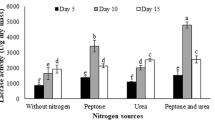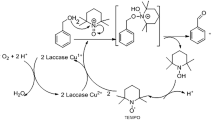Abstract
Parthenium sp., a belligerent noxious herbaceous wasteland weed, became a threat to environment and biodiversity, so its management is necessary to prevent future problems. A new laccase producing strain of white-rot fungus Pseudolagarobasidium acaciicola LA 1 was isolated and evaluated for laccase production through solid-state fermentation of different lignocellulosics biomass. Parthenium biomass was selected as a suitable substrate for laccase production and optimization studies were undertaken. The maximum laccase (34,444 U/g of dry weight) was achieved with Parthenium biomass as solid substrate within 7 days at 30 °C under optimized condition. SDS-PAGE and zymography confirmed the presence of single laccase of 62.8 kDa. Laccase functioned optimally at pH 4.5 and temperature of 60 °C with ABTS (2,2′-Azino-bis-3-ethylbenzothiazoline-6-sulfonic acid). The enzyme retained 94 % of its original activity at 60 °C for 30 min and was found to be highly stable within the pH ranges 4.0–7.0 for 24 h. The presence of Cu+2 (10 mM) and ethanol (10 % v/v) enhanced the laccase activity. Crude laccase was applied for decolorization of Remazol Brilliant Blue R (RBBR) and Reactive Black 5 (RB5). The biodegradation was monitored by UV–vis spectroscopy and 90 % decolorization of RBBR (100 mg/L) was observed within 4 h of incubation. This study shows the potential of P. acaciicola for production of thermostable laccase using Parthenium biomass and its application for dye decolorization.






Similar content being viewed by others
References
Couto, S.R., Herrera, J.L.T.: Industrial and biotechnological applications of laccases: a review. Biotechnol. Adv. 24, 500–513 (2006)
Ardag, A.H., Topuz, M.C.: Decolorization of turquoise blue HFG by Coprinus plicatilis for water bioremediation. Bioremediat. J. 18, 287–294 (2014)
Camarero, S., Ibarra, D., Martinez, A.T., Romero, J., Gutiérrez, A., del Río, J.C.: Paper pulp delignification using laccase and natural mediators. Enzyme Microb. Technol. 40, 1264–1271 (2007)
Cestari, A.R., Vieira, E.F., Vieira, G.S., Almeida, L.E.: Aggregation and adsorption of reactive dyes in the presence of an anionic surfactant on mesoporous aminopropyl silica. J. Colloid Interf. Sci. 309, 402–411 (2007)
Tong, M., Yuan, S.: Physiochemical technologies for HCB remediation and disposal: a review. J. Hazard. Mater. 229, 1–14 (2012)
Arora, D.S., Sharma, R.K.: Ligninolytic fungal laccases and their biotechnological applications. Appl. Biochem. Biotechnol. 160, 1760–1788 (2010)
Baldrian, P.: Purification and characterization of laccase from the white-rot fungus Daedalea quercina and decolorization of synthetic dyes by the enzyme. Appl. Microbiol. Biotechnol. 63, 560–563 (2004)
Nyanhongo, G., Gomes, J., Gübitz, G., Zvauya, R., Read, J., Steiner, W.: Production of laccase by a newly isolated strain of Trametes modesta. Bioresour. Technol. 84, 259–263 (2002)
de Castro, R.J.S., Sato, H.H.: Enzyme production by solid state fermentation: general aspects and an analysis of the physicochemical characteristics of substrates for agro-industrial wastes valorization. Waste Biomass Valoriz. 6(6), 1085–1093 (2015)
Thorn, R.G., Reddy, C.A., Harris, D., Paul, E.A.: Isolation of saprophytic basidiomycetes from soil. Appl. Environ. Microbiol. 62, 4288–4292 (1996)
Reese, E.T., Mandels, M.: Enzymatic hydrolysis of cellulose and its derivatives. Methods Carbohydr. Chem. 3, 139–143 (1963)
Bourbonnais, R., Paice, M.G.: Oxidation of non-phenolic substrates: an expanded role for laccase in lignin biodegradation. FEBS Lett. 267, 99–102 (1990)
Tien, M., Kirk, T.K.: Lignin-degrading enzymes from Phanerochaete chrysosporium: purification, characterization and catalytic properties of a unique H2O2-requiring oxygenase. Proc. Natl. Acad. Sci. USA 80, 2280–2284 (1984)
Wariishi, H., Valli, K., Gold, M.H.: Manganese (II) oxidation by manganese peroxidase from the basidiomycete Phanerochaete chrysosporium. Kinetic mechanism and role of chelator. J. Biol. Chem. 267, 23688–23695 (1992)
Dwivedi, P., Vivekanand, V., Ganguly, R., Singh, R.P.: Parthenium sp. as a plant biomass for the production of alkalitolerant xylanase from mutant Penicillium oxalicum SAUE-3.510 in submerged fermentation. Biomass Bioenerg. 33, 581–588 (2009)
Pandiyan, K., Tiwari, R., Singh, S., Nain, P.K., Rana, S., Arora, A., Singh, S.B., Nain, L.: Optimization of enzymatic saccharification of Alkali pretreated Parthenium sp. using response surface methodology. Enzyme Res. (2014). doi:10.1155/2014/764898
Bhattacharya, S.S., Garlapati, V.K., Banerjee, R.: Optimization of laccase production using response surface methodology coupled with differential evolution. New Biotechnol. 28, 31–39 (2011)
Zadrazil, F., Gonser, A., Lang, E.: Influence of incubation temperature on the secretion of extracellular ligninolytic enzymes of Pleurotus sp. and Dichomitus squalens into soil. In: Proceedings of the conference on enzymes in the environment: activity, ecology and applicants. 12–16 July (1999)
Mikiashvili, N., Elisashvili, V., Wasser, S., Nevo, E.: Carbon and nitrogen sources influence the ligninolytic enzyme activity of Trametes versicolor. Biotechnol. Lett. 27, 955–959 (2005)
Revankar, M.S., Lele, S.: Enhanced production of laccase using a new isolate of white-rot fungus WR-1. Process Biochem. 41, 581–588 (2006)
Kaluskar, V., Kapadnis, B., Jaspers, C., Pennickx, M.: Production of laccase by immobilized cells of Agaricus sp. Appl. Biochem. Biotechnol. 76, 161–170 (1999)
Sadhasivam, S., Savitha, S., Swaminathan, K., Lin, F.H.: Production, purification and characterization of mid-redox potential laccase from a newly isolated Trichoderma harzianum WL1. Process Biochem. 43, 736–742 (2008)
Munoz, C., Guillén, F., Martínez, A., Martínez, M.: Laccase isoenzymes of Pleurotus eryngii: characterization, catalytic properties, and participation in activation of molecular oxygen and Mn2+ oxidation. Appl. Environ. Microbiol. 63, 2166–2174 (1997)
Palonen, H., Saloheimo, M., Viikari, L., Kruu, K.: Purification, characterization and sequence analysis of a laccase from the ascomycete Mauginiella sp. Enzyme Microbiol. Technol. 33, 854–862 (2003)
Ling, Z.R., Wang, S.S., Zhu, M.J., Ning, Y.J., Wang, S.N., Li, B., Yang, A.Z., Zhang, G.Q., Zhao, X.M.: An extracellular laccase with potent dye decolorizing ability from white-rot fungus Trametes sp. LAC-01. Int. J. Biol. Macromol. 81, 785–793 (2015)
Postemsky, P.D., Delmastro, S.E., Curvetto, N.R.: Effect of edible oils and Cu (II) on the biodegradation of rice by-products by Ganoderma lucidum mushroom. Int. Biodeterior. Biodegrad. 93, 25–32 (2014)
Lorenzo, M., Moldes, D., Couto, S.R., Sanromán, M.A.: Inhibition of laccase activity from Trametes versicolor by heavy metals and organic compounds. Chemosphere 60, 1124–1128 (2005)
Liu, L., Lin, Z., Zheng, T., Lin, L., Zheng, C., Lin, Z.: Fermentation optimization and characterization of the laccase from Pleurotus ostreatus strain 10969. Enzyme Microbiol. Technol. 44, 426–433 (2009)
Yang, Y., Ding, Y., Liao, X., Cai, Y.: Purification and characterization of a new laccase from Shiraia sp. SUPER-H168. Process Biochem. 48, 351–357 (2013)
Birhanli, E., Yesilada, O.: Increased production of laccase by pellets of Funalia trogii ATCC 200800 and Trametes versicolor ATCC 200801 in repeated-batch mode. Enzyme Microb. Technol. 39, 1286–1293 (2006)
Sathishkumar, P., Balan, K., Palvannan, T., Kamala-Kannan, S., Oh, B.T., Couto, S.R.: Efficiency of Pleurotus florida laccase on decolorization and detoxification of the reactive dye Remazol Brilliant Blue R (RBBR) under optimized conditions. CLEAN Soil Air Water 41, 665–672 (2013)
Acknowledgments
Authors are thankful to National Fund for Basic, Strategic and Frontier Application Research in Agriculture, India (ICAR-NFBSFARA) for funding the research activities under biofuel project (Grant No. NFBSFARA/AE2006/2010-11).
Author information
Authors and Affiliations
Corresponding author
Electronic supplementary material
Below is the link to the electronic supplementary material.
Rights and permissions
About this article
Cite this article
Adak, A., Tiwari, R., Singh, S. et al. Laccase Production by a Novel White-Rot Fungus Pseudolagarobasidium acaciicola LA 1 Through Solid-State Fermentation of Parthenium Biomass and Its Application in Dyes Decolorization. Waste Biomass Valor 7, 1427–1435 (2016). https://doi.org/10.1007/s12649-016-9550-0
Received:
Accepted:
Published:
Issue Date:
DOI: https://doi.org/10.1007/s12649-016-9550-0




